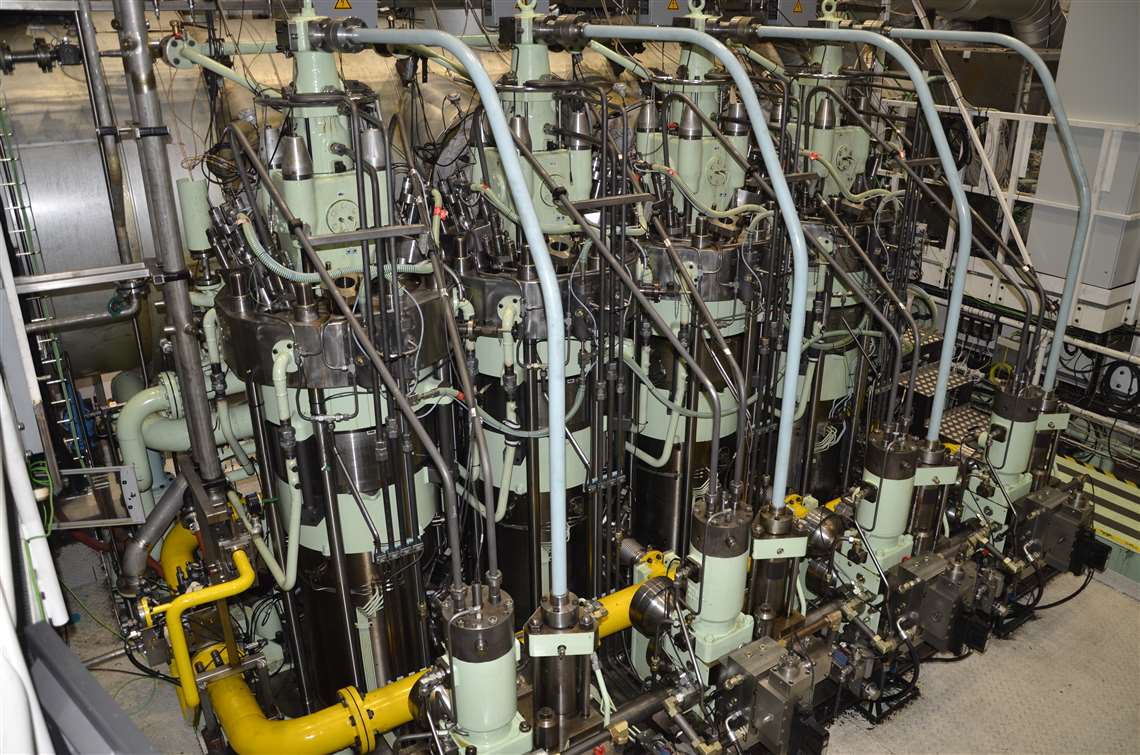MAN Energy Solutions launched low-speed dual-fuel engine
18 March 2021
Live-streamed ceremony from MAN Energy Solutions’ Research Center in Denmark for the launch of a new low-speed, dual-fuel engine designed for LNG and fuel-oil.
MAN Energy Solutions unveiled its new low-speed, dual-fuel engine – an MAN B&W ME-GA type designed for LNG/fuel-oil running – during a live-streamed ceremony from its Copenhagen Research Centre, Danmark, where the engine’s operation has been demonstrated for the first time to the public.
The new engine is an Otto-cycle variant of the company’s ME-GI engine that uses the diesel cycle, and is compliant with IMO Tier 2 and Tier 3 emissions regulations in gas mode thanks to its pre-mixed combustion that results in low NOx emissions.
 The new MAN B&W ME-GA low speed, dual-fuel engine was demonstrated live at the MAN’s Research Center in Copenhagen
The new MAN B&W ME-GA low speed, dual-fuel engine was demonstrated live at the MAN’s Research Center in Copenhagen
The engine was designed in close cooperation with MAN Energy Solutions’ licensee Hyundai Heavy Industry and answered a specific demand from the market of LNG carriers using boil-off gas from the cargo as a fuel for the engine.
MAN Energy Solutions’ Principal Promotion Manager, Peter H. Kirkeby said that the market for LNG carriers shows a very good trend with new liquefaction trains coming online around the world, creating more request for carrier ships. MAN Energy Solutions forecasted that an average of 70 ships per year can be commissioned in the coming years.
The ME-GA engine is already specified in LNG carrier newbuilds but more details cannot be communicated at this time.
Thomas S. Hansen, head of Two-Stroke Promotion & Customer Support, explained some of the engine’s technical characteristics, saying that to fully utilise the engine’s dual-fuel potential in IMO Tier 3 areas, the engine is also being offered with an integrated Exhaust Gas Recirculation (EGR) that ensures compliance when in diesel mode.
According to MAN Energy Solutions, EGR will enable the ME-GA to reduce specific gas consumption by about 3%, and specific fuel-oil consumption by 5%. It will also significantly reduce methane slip by 30 to 50%, and improve the stability of the Otto-cycle combustion process. EGR will enable the ME-GA to meet IMO Tier 3 requirements in both fuel oil and gas modes without additional aftertreatment.
Hansen explained that the ME-GA EGR solution is a high-pressure system, integrated into the engine in a very compact solution – the EGR unit itself actually does not change the engine footprint. MAN Energy Solutions already has more than 120 engines in operation with its EGR system.
The volume requirements of the ME-GA EGR system are significantly lower with, for example, less pipework required than for low-pressure EGR solutions. Its design-similarity to that of ME-C engines’ EGR systems will lower its price point, since the supply chain and components are already mature.
Based on the well-proven MAN B&W dual-fuel design the MAN B&W ME-GA uses an efficient ignition concept with pre-mixed Otto principle and a gas-admission system that delivers safe and reliable operation. “A specially developed Safe Gas Admission Valve (SGAV) insures an enhanced engine operation; it features a window valve that offers a double safety function,” added Hansen. “The gas admission system has a double-wall pipe installation with bi-directional flow.
“One other key characteristic of this engine is the robust piston/ring pack, taken from MAN’s experience with ME-GE engines, featuring three piston rings and insuring a uniform pressure drop.”
The ME-GA engine is available in 60- and 70-cm cylinder bore versions (G60ME-C10.5-GA and G70ME-C10.5-GA) with a 50-cm bore version coming soon.
MAN Energy Solutions aims to start testing the first, commercial ME-GA design by the end of this year, with the first engine delivery following in early 2022.
During the ceremony, the ME-GA engine was demonstrated in operation with a ramping up from 25% load in gas mode to 50% load where the fuel supply was seamlessly switched to diesel within one engine revolution. The engine was then further pushed to higher load and turned back to gas mode.
MAN Energy Solutions reports that its portfolio of two-stroke, dual-fuel engines has accumulated over 1.6 million operating hours from the 155 engines (6.3 GW) currently in service – all running on clean fuels such as LNG, LPG, ethane and methanol. With fuel prices and availability currently in flux, MAN Energy Solutions expects the option of retrofitting to dual-fuel engines to increasingly become a necessity.
The company is also putting quite some emphasis in the research on alternative fuels and announced an engine running with ammonia to be introduced in 2024, with a retrofit package to become available roughly a year later.
STAY CONNECTED




Receive the information you need when you need it through our world-leading magazines, newsletters and daily briefings.
POWER SOURCING GUIDE
The trusted reference and buyer’s guide for 83 years
The original “desktop search engine,” guiding nearly 10,000 users in more than 90 countries it is the primary reference for specifications and details on all the components that go into engine systems.
Visit Now
CONNECT WITH THE TEAM









